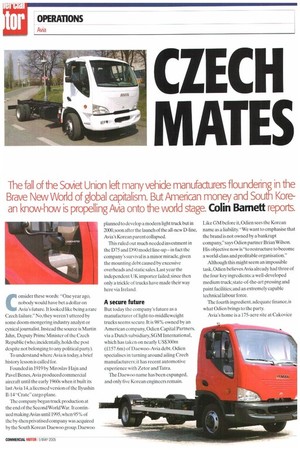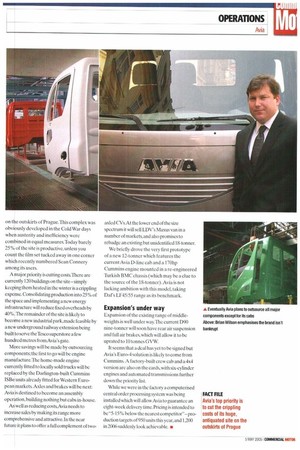CZECH MATES
Page 66

Page 67

If you've noticed an error in this article please click here to report it so we can fix it.
Consider these words: "One year ago, nobody would have bet a dollar on Avia's future. It looked like being a rare Czech failure." No, they weren't uttered by some doom-mongering industry analyst or cynical journalist. Instead the source is Martin Jahn, Deputy Prime Minister of the Czech Republic (who, incidentally, holds the post despite not belonging to any political party).
To understand where Avia is today, a brief history lesson is called for.
Founded in 1919 by Miroslav Hajn and Pavel Benes. Avia produced commercial aircraft until the early 1960s when it built its last Avia 14,a licensed version of the Ilyushin 11-14 "Crate" cargo plane.
The company began truck production at the end of the SecondWorldWar. It continued making Avias until 1995, when 95% of the by-then privatised company was acquired by the South Korean Daewoo group. Daewoo planned to develop a modern light truck but in 2000, soon after the launch of the all-new D-line, Avia's Korean parent collapsed.
This ruled out much needed investment in the D75 and D90 model line-up — in fact the company's survival is a minor miracle, given the mounting debt caused by excessive overheads and static sales. Last year the independent UK importer failed; since then only a trickle of trucks have made their way here via Ireland.
A secure future
But today the company's future as a manufacturer of light-to-middleweight trucks seems secure. It is 98% owned by an American company, Odien Capital Partners, via a Dutch subsidiary, SGM International, which has taken on nearly US$300m (fl57.6m) of Daewoo-Avia debt. Odien specialises in turning around ailing Czech manufacturers; it has recent automotive experience with Zetor and Tatra.
The Daewoo name has been expunged, and only five Korean engineers remain. Like GM before it, Odien sees the Korean name as a liability "We want to emphasise that the brand is not owned by a bankrupt company," says Odien partner Brian Wilson. His objective now is "to restructure to become a world-class and profitable organisation."
Although this might seem an impossible task. Odien believes Avia already had three of the four key ingredients: a well-developed medium truck; state-of-the-art pressing and paint facilities; and an extremely capable technical labour force.
The fourth ingredient, adequate finance, is what Odien brings to the party.
Avia's home is a 175-acre site at Cakovice on the outskirts of Prague. This complex was obviously developed in the Cold War days when austerity and inefficiency were combined in equal measures. Today barely 25% of the site is productive, unless you count the film set tucked away in one corner which recently numbered Sean Connery among its users.
A major priority is cutting costs.There are currently 120 buildings on the site —simply keeping them heated in the winter is a crippling expense. Consolidating production into 25% of the space and implementing a new energy infrastructure will reduce fixed overheads by 40%.The remainder of the site is likely to become a new industrial park,made feasible by a new underground railway extension being built to serve the Tesco superstore a few hundred metres fromAvia's gate.
More savings will be made by outsourcing corn ponents; the first to go will be engine manufacture.The home-made engine currently fitted to locally sold trucks will be replaced by the Darlington-built Cummins ISBe units already fitted for Western European markets. Axles and brakes will be next: Avia is destined to become an assembly operation, building nothing but cabs in-house.
As well as reducing costs,Avia needs to increase sales by making its range more comprehensive and attractive. In the near future it plans to offer a full complement of two axled CVs.At the lower end of the size spectrum it will sell LDV's Maxus van in a number of markets, and also promises to rebadge an existing but unidentified 18-tonner.
We briefly drove the very first prototype of a new 12-tonner which features the current Avia D-line cab and a 170hp Cummins engine mounted in a re-engineered Turkish BMC chassis (which may be a clue to the source of the 18-tonner). Avia is not lacking ambition with this model, taking Des LF45/55 range as its benchmark.
Expansion's under way
Expansion of the existing range of middleweights is well under way.The current D90 nine-tonner will soon have rear air suspension and full air brakes, which will allow it to be uprated to 10 tonnes GVW.
It seems that a deal has yet to be signed but Avia's Euro-4 solution is likely to come from Cummins. A factory-built crew cab and a 4x4 version are also on the cards, with six-cylinder engines and automated transmissions further down the priority list.
While we were in the factory a computerised central order processing system was being installed which will allow Avia to guarantee an eight-week delivery time. Pricing is intended to be "5-15% below the nearest competitor"— production targets of 950 units this year. and 1;200 in 2006 suddenly look achievable. is






































































































































































































